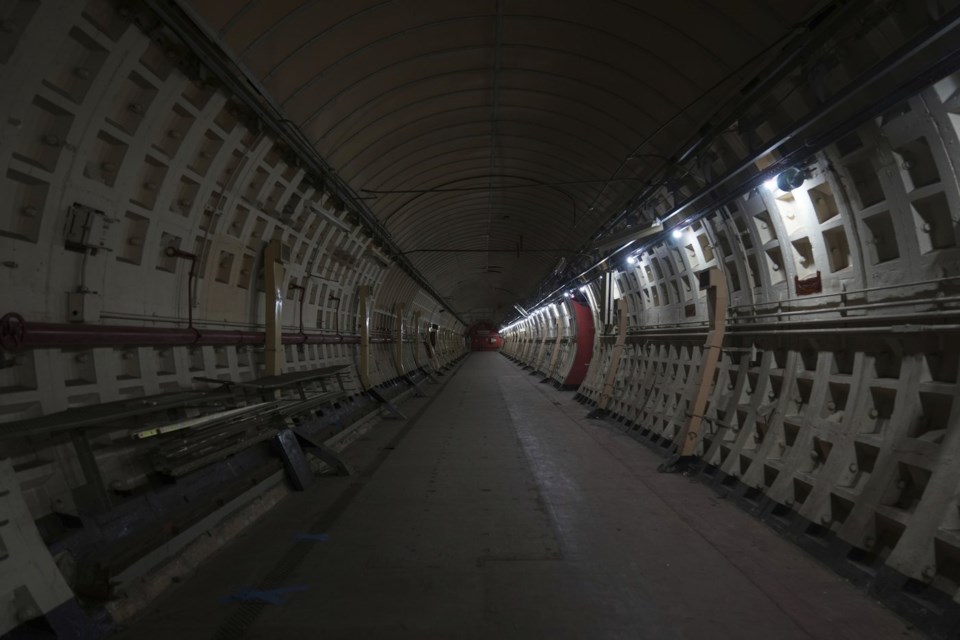LONDON (AP) — There is a history-rich part of London that few people have seen, where the city braced for the Blitz, James Bond’s creator got inspiration and secret Cold War messages passed between Washington and Moscow.
It’s a network of tunnels 100 feet (30 meters) below the streets that was secret for decades — but could be the city’s next big tourist destination. Local authorities have approved plans to fill the 90,000 square-foot (8,400 square-meter) site with an intelligence museum, an interactive World War II memorial and one of the world’s deepest underground bars.
“It’s an amazing space, an amazing city,” said Angus Murray, chief executive of The London Tunnels, as subway trains rattled overhead. “And I think it tells a wonderful story."
A vast bomb shelter
The tunnels lie directly below London Underground’s Central Line in the city’s Holborn area. Work to dig them began in secret in 1940, when Britain feared invasion by Nazi Germany. They were designed to shelter up to 8,000 people in a pair of parallel tunnels 16 1/2 feet (5 meters) wide and 1,300 feet (400 meters) long.
The tunnels were never used for that purpose; by the time they were finished in 1942 the worst of the Blitz was over, and Underground bosses had opened up subway stations as air raid shelters for Londoners.
Instead, the tunnels became a government communications center and a base for the Special Operations Executive, a clandestine unit that sent agents — many of them women — on perilous sabotage missions in Nazi-occupied territory under orders from Prime Minister Winston Churchill to “set Europe ablaze.”
A naval officer named Ian Fleming was a liaison officer to the SOE, and the subterranean HQ may have provided inspiration for the world of secret agent 007 that he went on to create.
“This truly is the Q Branch of James Bond,” said Murray, referring to the thrillers' fictional MI6 quartermaster and gadget-maker.
After the war, more tunnels were added to the complex and the site became a secure telephone exchange. From the mid-1950s it was a terminus of the first trans-Atlantic undersea telephone cable. After the Cuban Missile Crisis brought the world to the brink of nuclear war in 1962, a “red telephone” hotline between the Pentagon and the Kremlin was established and ran through here.
Up to 200 people worked underground, bound to secrecy but with the compensation of an onsite canteen and bar. For a time, the site also housed a bunker to be used by the government in the event of nuclear war.
By the 1980s, technology had moved on and British Telecom moved out. The tunnels lay largely forgotten until BT sold them in 2023 to Murray’s private equity-backed group.
Plans include a memorial to the more than 40,000 civilians killed by German bombing in the war, cultural exhibitions and a nightspot that Murray boasts will be “the deepest bar in the world in a city.”
Secret wartime history
It also will house Britain’s Military Intelligence Museum, which is currently tucked away on a military base north of London with limited public access. Museum bosses have agreed to move a collection covering more than 300 years of history to the tunnels, bringing a much higher profile for a story they believe needs to be told.
”It’s not targeted at people who already have an interest in military topics,” said the chair of the museum’s board of trustees, who gave only his first name, Alistair, because of the museum’s connection to Britain's armed forces.
“A heavy theme that will run through the new museum is that there are skills and tools that military intelligence has developed over years and centuries … and the fundamental one is, how do you tell truth from lies?” he said. “That’s a very big theme of now.”
The museum also will flesh out the secret story of the Special Operations Executive. The museum’s collection contains agent messages, supplies, weapons and sabotage equipment from the SOE’s wartime adventures.
“Most of the people that worked in SOE never talked about it, either at the time or afterwards, and many of the records have disappeared,” Alistair said. “So a lot is known about SOE, but we don’t know everything, and the chances are we will never know everything.”
A unique attraction
For now, the tunnel entrance is through an unmarked door in an alley, and walking the cool, dim corridors brings the thrill of discovering a hidden corner of history. Within the thick steel and concrete walls are chunky old generators and telecoms equipment, a staff canteen with its kitchen still intact, and the bar, its 1960s orange and brown décor giving off retro “Austin Powers” vibes
Here and there are graffiti tags and a few items left by urban explorers who snuck in over the years, including a set of bowling pins with ball, and — incongruously — a bear costume.
London Tunnels aims to open in 2028, and to attract up to 4.2 million tourists a year. That may sound ambitious, but Murray says the site’s mix of “history and heritage and novelty” makes it a unique draw.
“If you go home and say, ‘I went to this really cool tunnel today,’ then we’re halfway there,” he said. “If what’s inside of it is even better, you’re going to go ‘Oh that’s fantastic.’”
Jill Lawless, The Associated Press




